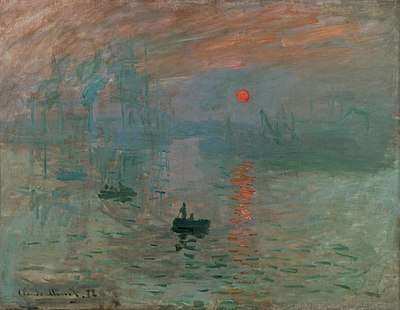John Russell (Australian painter)
John Peter Russell (16 June 1858 – 30 April 1930) was an Australian impressionist painter.
John Peter Russell | |
|---|---|
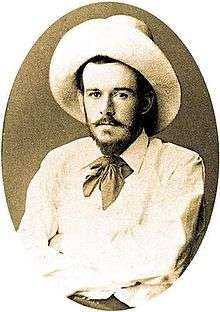 Photograph of Russell, c. 1883 | |
| Born | John Peter Russell 16 June 1858 Sydney, New South Wales, Australia |
| Died | 30 April 1930 (aged 71) Sydney, New South Wales, Australia |
| Nationality | Australian |
| Known for | Painting |
| Movement | Impressionism |
| Spouse(s) | Marianna Antonietta Mattiocco |

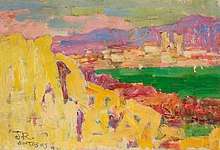
Born and raised in Sydney, Russell moved to Europe in his late teenage years to attend art school. There, he befriended fellow pupil Vincent Van Gogh and, in 1886, painted the first oil portrait of the artist, now held at the Van Gogh Museum. That same year, Russell painted with Claude Monet at Belle Île. Russell moved there soon after with his wife, Marianna Russell, one of sculptor Auguste Rodin's favourite models. Henri Matisse visited Russell at Belle Île in the 1890s, and later credited the Australian with introducing him to impressionist techniques and colour theory.
Despite painting prolifically and maintaining close ties with the European avant-garde, Russell rarely exhibited his works and, having received a large inheritance from his father, showed no interest in making money from art. After his wife died in 1907, Russell, grief-stricken, destroyed hundreds of his paintings. He returned to Sydney in old age where he died in relative obscurity. His niece, Australian artist Thea Proctor, did much to posthumously promote Russell's art, and by the late 20th-century, a number of biographies and exhibitions had helped to restore his reputation as a significant artist. Today his works are held in major galleries in his home country and in Europe, including the Musée d'Orsay and the Musée Rodin in Paris.[1][2]
While in Europe, Russell maintained correspondence with Australian impressionist painter Tom Roberts, updating him on developments in French impressionism. Since he remained in Europe for much of his career and descended into obscurity after his death, Russell became known as Australia's "lost impressionist".
Life
Early years
John Peter Russell was born in the Sydney suburb of Darlinghurst, the eldest of four children of John Russell, a Scottish engineer, and his wife Charlotte Elizabeth, née Nicholl, from London.[3] John Russell senior's engineering firm was responsible for a good deal of the ironwork produced in Sydney in the 19th century.[4] J. P. Russell was a nephew of Sir Peter Nicol Russell. Russell was educated at the Goulburn School in Garrooriagang.[5] Russell moved to England at the age of eighteen, initially to take up an engineering apprenticeship.[1][5] He later used the considerable inheritance he received from his father to enrol at the Slade School of Fine Art, University College London, on 5 January 1881 and studied under Alphonse Legros for three years.[3][6] Russell then went to Paris to study painting under Fernand Cormon. His fellow students there included Henri de Toulouse-Lautrec and Émile Bernard. Russell was a man of means and, having married a beautiful Italian seamstress and model of Auguste Rodin's, Marianna Antonietta Mattiocco,[2][7] he settled at Belle Île off the coast of Brittany, where he designed his own home and established an artists' colony.[6] Russell was the first non-native to move to the island, leading locals to call his home overlooking Port Goulphar "Le Chateau de l'Anglais".[1][7] He would have 11 children with Mattiocco, of whom six, five sons and a daughter, survived.[2][8]
Emerging artist
Russell met Vincent van Gogh in Paris and formed a close friendship with him.[9] The two artists particularly bonded over being foreigners in the Parisian avant-garde scene.[10] They maintained correspondence, and some of Van Gogh's private letters reveal his deep fondness for Russell and his art.[11] After his first summer in Arles in 1888 he sent twelve drawings of his paintings to Russell, to inform him about the progress of his work. Claude Monet often worked with Russell at Belle Île and influenced his style, though it has been said that Monet preferred some of Russell's Belle Île seascapes to his own. In 1890, Russell left Belle Île and traveled to Antibes in a horse-drawn cart, where he rented a house for the winter and produced some of his most acclaimed work.[6] Due to his substantial private income Russell did not attempt to make his pictures well known. In the 1880s and 1890s, Russell hewed closely to pure French impressionist style.[10]
Russell's daughter, Madame Jeanne Jouve, known in Paris as a singer, has stated that he had built up a collection of impressionist works – van Gogh, Gauguin, Bernard, Guillaumin – which he intended to give to Australia, but none is known to have survived beyond his death.[12]
In 1907, Marianna Russell died in Paris of cancer.[4] Grief-stricken, Russell buried her next to his home on Belle Île and destroyed 400 of his oils and watercolours.[10] Auguste Rodin despaired at the destruction of "those marvels", and in one of his final letters to Russell, said "Your works will live, I am certain. One day you will be placed on the same level with our friends Monet, Renoir, and Van Gogh."[12] He married his second wife in 1912, the American singer Caroline de Witt Merrill who was a friend of Russell's daughter and went by the stage name of Felize Medori.[10][6][1] Russell and his new wife moved between Italy, Switzerland, and England, where Russell's five sons served in the Allied forces during the First World War.[1][2] In 1922, Russell briefly lived in New Zealand where he helped one of his sons start a citrus farm.[1]
In 1921, Russell returned to the Sydney area, where he lived in a fisherman's cottage in suburb of Watsons Bay and had a small wooden studio on Sydney Harbour.[1][7] He suffered a fatal heart attack in 1930 while lifting rocks to build a wall outside his cottage.[2][7]
Thea Proctor, a cousin of Russell's prominent in Sydney art and society circles, did much to promote his work in her later years.[13]
Russell was a friend of Auguste Rodin and Emmanuel Frémiet, and his wife's beauty is immortalised in Rodin's Minerve sans Casque and Fremiet's Joan of Arc. His portrait of van Gogh, painted about 1886–87, was allegedly Van Gogh's favourite depiction of himself: the Dutch artist even told wrote his brother Theo, ten months before his death, exhorting him to "take good care of my portrait by Russell, which means a lot to me".[5] The painting of Van Gogh was acquired by the Van Gogh Museum, at Amsterdam in 1938.[14][5] A sheet of portrait drawings of van Gogh is at the Art Gallery of New South Wales.[15] Two water-colours and a small oil painting are in the National Gallery of Victoria in Melbourne, and there is a drawing in the Adelaide collection.
He was also a lifelong friend of Tom Roberts, one of the main figures of the Australian Heidelberg School of impressionism. Russell was not directly involved in this movement, giving him the title "Australia's Lost Impressionist".[16]
Style and works
Russell first became interested in Impressionism in Paris, where he tried some of the techniques in his own works. In 1885, Russell made a trip to Cornwall and visited plein air colonies. This would lead to his inevitable friendship with Vincent Van Gogh, whom he formed a friendship with after moving to Paris in the year after. In 1897 and 1898 Henri Matisse visited Belle Île. Russell introduced him to impressionism and to the work of van Gogh (who was relatively unknown at the time). Matisse's style changed radically, and he would later say "Russell was my teacher, and Russell explained colour theory to me."[17] Russell was particularly known for his skill as a colourist; during his stay on Belle Île he ground and mixed all his own pigments.[2] In the late 1880s, he even met Claude Monet who would later become a big name in the field. [18] Russell referred to Monet as "the prince of Impressionists," while they painted. They were close friends and often saw each other.[19] Russell later bought land on the island where the two met and lived there for the next twenty years. He visited places around his now home and was inspired by the clear light and bright colors. This led to Russell creating serious works in plein air and showed his growth as an artist. We could say the trip long ago to Cornwall led to these works of art.
Gallery
 Peonies and Head of a Woman, 1887, National Gallery of Victoria
Peonies and Head of a Woman, 1887, National Gallery of Victoria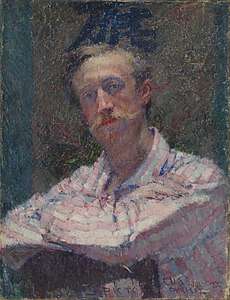 Dr Will Maloney, 1887, National Gallery of Victoria
Dr Will Maloney, 1887, National Gallery of Victoria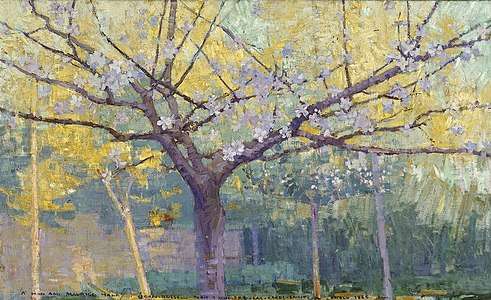 The garden, Longpré-les-Corps-Saints, 1887, private collection
The garden, Longpré-les-Corps-Saints, 1887, private collection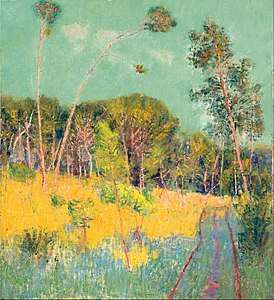 A Clearing in the Forest, 1891, Art Gallery of South Australia
A Clearing in the Forest, 1891, Art Gallery of South Australia In the Afternoon, Art Gallery of New South Wales
In the Afternoon, Art Gallery of New South Wales In the Morning, Alpes Maritimes from Antibes, c. 1891
In the Morning, Alpes Maritimes from Antibes, c. 1891 Belle Ile en mer, 1898
Belle Ile en mer, 1898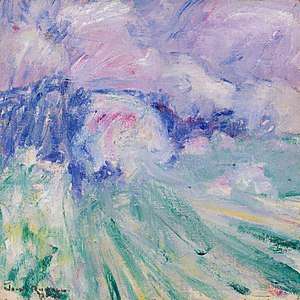 Rough Sea, Belle-Île, 1900, National Gallery of Victoria
Rough Sea, Belle-Île, 1900, National Gallery of Victoria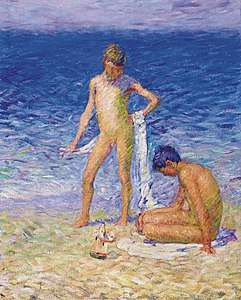 Boys on the Beach, Belle Ile, c. 1900
Boys on the Beach, Belle Ile, c. 1900 La Pointe de Morestil, Calm Sea, 1901
La Pointe de Morestil, Calm Sea, 1901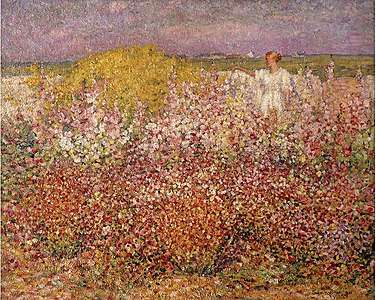 Mrs. Russell among the Flowers in the Garden of Goulphar, Belle-Île, 1907, Musée d’Orsay
Mrs. Russell among the Flowers in the Garden of Goulphar, Belle-Île, 1907, Musée d’Orsay
See also
- Visual arts of Australia
References
- "John Peter Russell. Part 2 – Belle Île, Monet and Matisse". my daily art display. 9 October 2013. Retrieved 8 August 2018.
- Galbally, Ann E., "Russell, John Peter (1858–1930)", Australian Dictionary of Biography, National Centre of Biography, Australian National University, retrieved 8 August 2018
- Galbally, Ann E.: "Russell, John Peter (1858–1930"), Australian Dictionary of Biography, Volume 11, Melbourne University Press, 1988, pp 483-484. Retrieved 25 November 2009
- Mendelssohn, Joanna. "From Monet to Rodin, John Russell: Australia's French Impressionist maps artistic connections". The Conversation. Retrieved 8 August 2018.
- "John Peter Russell. Part 1. Van Gogh and portraiture". my daily art display. 4 October 2013. Retrieved 8 August 2018.
- "John Russell :: The Collection :: Art Gallery NSW". www.artgallery.nsw.gov.au. Retrieved 8 August 2018.
- Turnbull, Sarah (13 July 2018). "John Russell: Van Gogh's little-known Aussie Impressionist mate". The Sydney Morning Herald. Retrieved 8 August 2018.
- "Bonhams : John Peter Russell (1859-1930) Dadone c.1900". www.bonhams.com. Retrieved 8 August 2018.
- Ronald Pickvance, Van Gogh in Saint-Remy and Auvers, pp. 62-63, Exhibition catalog, Published: Metropolitan Museum of Art 1986, ISBN 0-87099-477-8
- "John Russell, an Australian impressionist in France – in pictures". The Guardian. 22 July 2018. ISSN 0261-3077. Retrieved 8 August 2018.
- "The Burlington Magazine for Connoisseurs". Notes and Queries. s10-III (54): 19–20. 7 January 1905. doi:10.1093/nq/s10-iii.54.19e. ISSN 1471-6941.
- "The Art of John Peter Russell" Women's Weekly. 3 May 1967. p. 34
- Roger Butler, 'Proctor, Alethea Mary (Thea) (1879–1966)', Australian Dictionary of Biography, Volume 11, Melbourne University Press, 1988, p. 301.
- Australian Dictionary of Biography retrieved 17 February 2010
- Russell, John (1886–1888). "Five studies of Vincent van Gogh". AGNSW collection record. Art Gallery of New South Wales. Retrieved 10 May 2016.
- John Peter Russell: Lost Impressionist, Arts Today with Bruce James. abc.net.au. Retrieved on 3 February 2011.
- The Unknown Matisse..., ABC Radio National, 8 June 2005
- "Long, Sydney (Sid Long), (1878–1955), artist; President of the Australian Painter Etchers; Member Royal Art Society, NSW; Trustee National Art Gallery of NSW, 1933–49", Who Was Who, Oxford University Press, 1 December 2007, doi:10.1093/ww/9780199540884.013.u239977
- Wormald, John; Rennick, Kim (14 December 2019). National Policy, Global Giants. Cambridge University Press. doi:10.1017/9781108643948. ISBN 978-1-108-64394-8.
- Serle, Percival (1949). "Russell, John". Dictionary of Australian Biography. Sydney: Angus and Robertson.
- Salter, Elizabeth: The lost impressionist, Angus and Robertson, 1976. ISBN 0-207-95566-2
- Galbally, Ann: The Art of John Peter Russell, Sun Books, Melbourne, 1977. ISBN 0-7251-0271-3
- (in French) Onfray, Claude-Guy: Russell ou la lumière en héritage, Lorisse-Le livre d'histoire, Paris, 1995. ISBN 2-84178-019-8
- Galbally, Ann: A Remarkable Friendship: Vincent van Gogh and John Peter Russell, Melbourne University Press, Melbourne, 2008. ISBN 978-0-522-85376-6
External links
| Wikimedia Commons has media related to John Peter Russell. |
